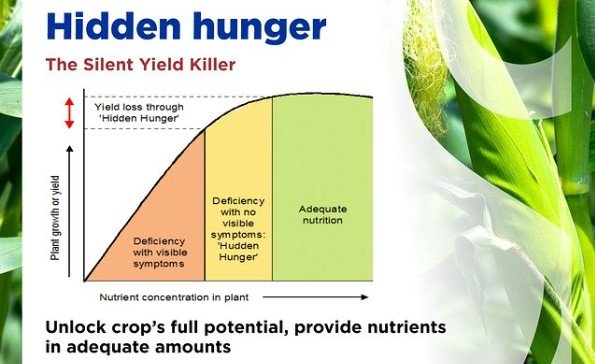It seems so simple, plants need nutrition to have a healthy life and grow. But we often get stuck on the idea that they only need sunlight when it is not even close. But what about when they do not eat those superfoods which are good for their growth? What the nutritionists call “hidden hunger”. This sneaky problem is difficult to notice as the plants will appear happy and healthy on the outside while lacking a key nutrient . If not addressed, it results in stunted growth and poor health. Hidden hunger refers to the fact that alerts’ are so subtle and therefore, we need to piece together this massive puzzle of meeting nutrient needs before it’s too late. Fertilizers play a key role in solving this puzzle, ensuring plants get the right nutrients before hidden hunger takes its toll.
It is often called ‘hidden hunger’ because it does not always show up in clear symptoms but rather hints at its presence through bad flowering, dull leaves or low harvests. Here are some reasons why this is important to know and deal :
Nutrient deficiencies: Even the slightest imbalance can hamper plant growth.
Effects on Growth: Shocking growth reflects a deficiency of essential vitamins and minerals.
Overall Health: Same as Humans Well-fed plants tend to live healthier and more productive lives. Paying attention to the needs of your green friends can help promote a healthy garden environment that promotes healthy, happy plants.
Understanding Hidden Hunger
Hidden hunger in crops is more prevalent than you might think. It’s like when you’re hungry. But your stomach doesn’t growl—and the next thing you know, you’re out of energy. Plants can’t tell us for sure that they’re starving. But they have a way of expressing themselves.
Definition of Hidden Hunger
Hidden hunger in plants is a condition in which plants suffer from a lack of essential nutrients. This is unlike acute starvation in which visible symptoms appear quickly. Hunger is subtle and hidden. At first glance, this plant appears healthy but struggles silently. This leads to stunted growth, low yields and increased susceptibility to pests and disease.
Causes of Plant Nutrient Deficiency
So why do plants secretly feel hungry?
Many of these offenders include:
Poor soil quality: Not all soil is created equal. Some soils naturally lack certain nutrients. Or, using it for many years without adding nutrients may deplete important minerals.
Unbalanced fertilization: Sometimes with eagerness to mate. We use too much of one nutrient to cover up the absorption of others.
Soil pH Level: If the soil is too acidic or too alkaline It may interfere with the plant’s ability to absorb nutrients efficiently.
Environment: Too much water or drought can prevent plants from consuming nutrients. Extremely high temperatures can also be dangerous.
Simply put, it doesn’t matter whether you’re dealing with land or potted plants. It is important to understand these factors in order to deal with the root of the problem.
Impact on Plant Health and Growth
The effects of hidden hunger are profound. This is what happens when plants don’t get the nutrients they need.
Stunted growth: Without adequate nutrition The plant will not be able to grow to its full size and potential.
Reduced yield: Nutrient deficiency means fewer flowers or fruit. This is bad news for gardeners and farmers.
Increased fragility: Poorly nourished plants are more vulnerable to disease and pests. This is because their natural defenses are weakened.
Hidden hunger can silently sabotage your efforts. This makes the plant weaker and less productive. This was a silent threat. .
Does plant show any symptoms ?
No, there is no guarantee that plants will exhibit overt signs of hunger. When a crop lacks nutrients from the soil but doesn’t exhibit any symptoms of a shortage, it’s known as “hidden hunger.” This may reduce the potential yield of the crop.
Note : Generally, nutrient like phosphorous and potassium will show the sign of hidden hunger
Solution for Hidden Hunger
The hunger hidden in the trees is a quiet problem. But it’s commonly found even the most trying gardeners can go undercover. To help you fight this hidden enemy. Let’s explore some top solutions to ensure your green friend stays healthy and vibrant.
Choosing the right fertilizer : Choosing the right fertilizer is important to prevent plant nutrient deficiency. Not all fertilizers are created equal. Therefore, you need to choose the right fertilizer for your plant’s specific needs.
Balanced Fertilizers: These fertilizers contain a blend of essential nutrients such as nitrogen (N), phosphorus (P) and potassium (K) and are ideal as a good starting point if you’re not sure your plants may be nutritionally deficient. What kind?
Micronutrients Fertilizers: Micronutrient fertilizers play an important role in preventing hidden hunger in plants. They may be lacking in the soil but are important for plant growth and development. If you identify specific deficiencies such as magnesium or iron deficiency. Concentrated fertilizers can precisely target these problems. These are often listed as micronutrients or come with additional supplements to meet special needs.
Organic Alternatives: Don’t forget organic fertilizer! It’s made from natural materials like compost or manure, which slowly release nutrients and improve soil health over time. By nurturing your plants, you will have the dual benefit of improving soil health.
Conclusion and Final Thoughts
In summary, tackling hidden hunger in agriculture is critical to improving crop health. Product quality and overall food security A lack of micronutrients in the soil can lead to reduced crop yields and nutrient-deficient food.Human health is impacted, particularly in developing nations by implementing environmentally friendly techniques like balanced fertilisation. Utilising precision farming and adding biological fertilisers We can deal with hidden hunger. This guarantees that the crops receive the necessary nutrients. This method enhances the quality of the food as well. However, it also advances both economic viability and long-term environmental sustainability.

